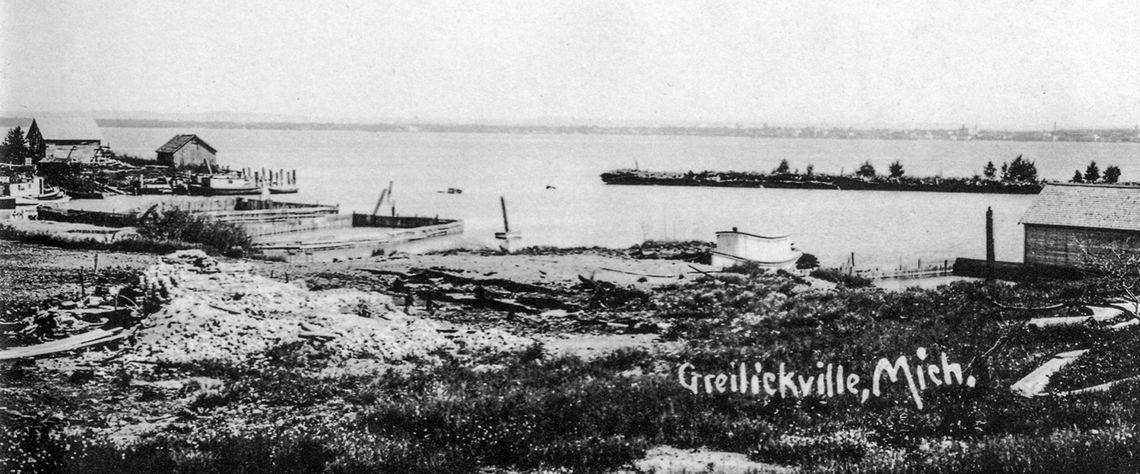The following is an excerpt from “Meet Me At The Dock in Greilickville, Grand Traverse Bay” by author Kathleen Firestone.
Copies of her books are available at local book stores or directly from her.
In 1847 at the foot of Grand Traverse Bay, Harry Boardman and his son Horace arrived in present-day Traverse City, with their little sloop Lady of the Lake. The next year they established a small water-powered sawmill along Mill Creek, now known as Kids Creek. This is beyond the dividing line of counties that would become Grand Traverse and Leelanau.
In Grand Traverse, in 1851, Hannah, Lay and Company bought the river improvements the Boardmans had made an began their quest of becoming the most notable lumber company in the area. The Boardmans now have a river, a lake, and other Traverse City locations named after them.
The hills and valleys of the Leelanau Peninsula were also covered with forests. A 252-acre lake with streams meandering to Grand Traverse Bay reflected the skies above future Greilickville, and those streams promised water power for running machinery. The eastern bank of the small lake held quality clay — the kind that could become building blocks for homes and businesses. There was room for farm homes, barns and fields. The eastern side of the 37-mile long peninsula was the gateway from the new Traverse City settlement into the land of Leelanau, with its own pioneer homes and docks to the north, at Suttons Bay, Bingham, Omena and Northport, and to the west at Empire, Glen Arbor, Port Oneida and Leland.
It’s easy to see why present Greilickville was first called Norrisville of Norristown. Across Lake Michigan, in Wisconsin, Seth Hall Norris and his wife Nancy boarded a schooner in Racine, along with their four sons, Charles (age 20), Martin (17), John (14) and Albert (10) and two milk cows, two other cattle, and their household belongings.
The oldest son, George, may not have come to Michigan with them. He was born in 1825 and died several years later in Minnesota. The family’s first top in northern Michigan was at Elk Rapids, across Grand Traverse Bay from the Leelanau Peninsula, on June 12, 1851. It was not their first time to live in Michigan, having lived in its lower communities before moving to Wisconsin. After a few days in Elk Rapids, the Norris family explored Grand Traverse Bay on the Wah-bu-see/Wabezee (and other spellings.)
This little boat became well known on both sides of the bay. It as owned by a group of Native American men, and a man named David assisted the Norris family. He took them to the Boardman River outlet, and they stayed temporarily on the “block house” built by Horace Boardman for his mill hands. The Norris livestock had been driven along the shore by other Indian guides.
Seth Norris, likely in the company of his sons, scouted the territory until they located the perfect place where the young men could building their futures. The original Norris land reached from present-day Grand View Parkway to the Pathfinder School, more than 500 acres. One-hundred, thirtyeight acres of land lay between Grand Traverse Bay and a pleasant lake with its streams running into the bay. This water resource would soon be named Cedar Lake.
After building a home and barn on the new land and clearing a field for crops, the Norris family set to work on other dreams. Antoine Manseau had logged to build a mill along that stretch of the bay, but the Norris brothers had registered the property as theirs before Manseau got a chance. The Manseaus were, instead, entrepreneurs up the coast and south of Peshawbestown and around the Leelanau Peninsula at Leland.
Albert Norris, being the youngest in the Norris family, began attending school in the Traverse City settlement’s first classroom, the year the family arrived in Leelanau. More settlers were coming to the southern part of Leelanau, as well as to Grand Traverse. The Norrises could benefit from the dreams and services of others, and others could benefit from them.
Three years after the Seth and Nancy Norris family arrived. Godfrey Greilick, his wife Theresa (Lichtner) and their sons Joseph (age 19), Anthony (15), John (13) and Edward (9) and daughter, Mary (11) became neighbors of the Norris family. Godfrey Greilick had been “a prominent contractor and builder” in Austria. The Greilicks left their homeland in 1848, bound for America, with dreams of prosperity. Sadly, 14-year-old son Ferdinand died part way across the Atlantic and was buried at sea. What a heartache this would have been for the remaining family.
After spending six years in New York, and another two in Chicago, the Greilicks arrived at North Unity, Leelanau County, in 1853, along with Bohemian friends, the Shaldas and Kratochvils. The Greilicks moved to the west shore of Cedar Lake in 1854, just a few miles from the Norris family and Grand Traverse Bay.
The Greilick’s newly-built home was a busy place, with father and sons coming and going as they found ways to make a living. Theresa likely spent a lot of time preparing meals for hungry men, with the help of daughter Mary. Godfrey Greilick built a small sawmill, in 1856, across Cedar Creek from the Norris property. Water from the creek was diverted into a sluice box to power the mill. Godfrey’s son Joseph worked with his father at the sawmill, while Anthony, John and Edward Greilick were first in the employ of Hannah, Lay & Co. which became the biggest lumber producer in Grand Traverse County. Later, son Joseph also work for Hannah, Lay. Theresa Greilick had the same year the Greilicks came to Leelanau. Daughter Mary was the only girl in the family of brothers.








